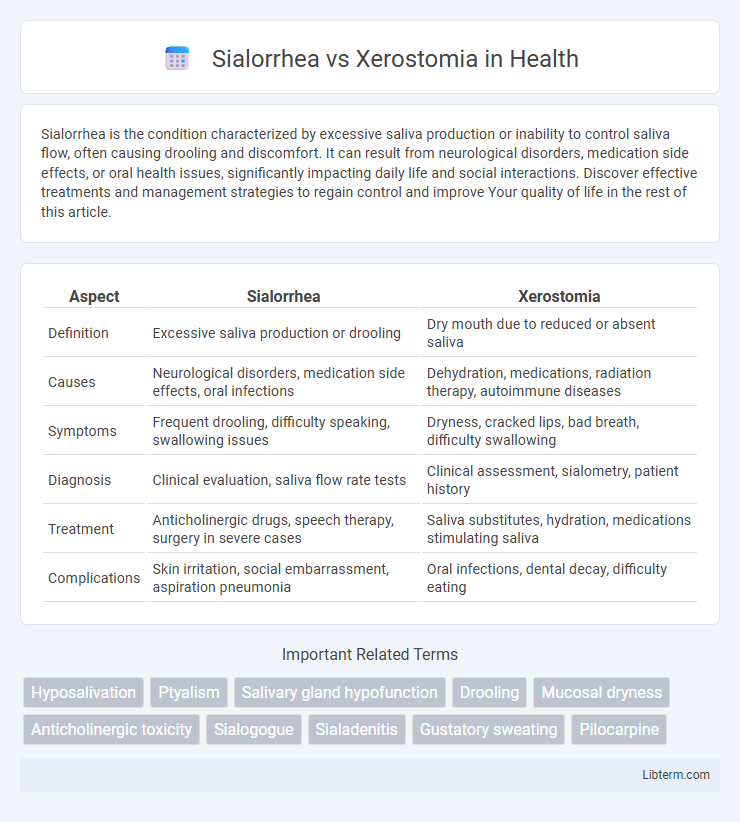Sialorrhea is the condition characterized by excessive saliva production or inability to control saliva flow, often causing drooling and discomfort. It can result from neurological disorders, medication side effects, or oral health issues, significantly impacting daily life and social interactions. Discover effective treatments and management strategies to regain control and improve Your quality of life in the rest of this article.
Table of Comparison
| Aspect | Sialorrhea | Xerostomia |
|---|---|---|
| Definition | Excessive saliva production or drooling | Dry mouth due to reduced or absent saliva |
| Causes | Neurological disorders, medication side effects, oral infections | Dehydration, medications, radiation therapy, autoimmune diseases |
| Symptoms | Frequent drooling, difficulty speaking, swallowing issues | Dryness, cracked lips, bad breath, difficulty swallowing |
| Diagnosis | Clinical evaluation, saliva flow rate tests | Clinical assessment, sialometry, patient history |
| Treatment | Anticholinergic drugs, speech therapy, surgery in severe cases | Saliva substitutes, hydration, medications stimulating saliva |
| Complications | Skin irritation, social embarrassment, aspiration pneumonia | Oral infections, dental decay, difficulty eating |
Understanding Sialorrhea and Xerostomia
Sialorrhea, characterized by excessive saliva production, often results from neurological disorders or medication side effects, leading to drooling and social discomfort. Xerostomia, or dry mouth, stems from reduced salivary gland function caused by factors like dehydration, autoimmune diseases, or radiation therapy, increasing the risk of oral infections and dental caries. Differentiating between Sialorrhea and Xerostomia is essential for targeted treatment strategies that address the underlying causes and improve patient quality of life.
Causes of Sialorrhea
Sialorrhea is primarily caused by excessive saliva production or impaired saliva clearance, often linked to neurological disorders such as Parkinson's disease, cerebral palsy, or stroke. Medications like clozapine and pilocarpine can also stimulate salivary glands, leading to sialorrhea. In contrast, xerostomia results from reduced saliva production due to factors like dehydration, Sjogren's syndrome, or the side effects of anticholinergic drugs.
Causes of Xerostomia
Xerostomia, commonly known as dry mouth, is primarily caused by reduced saliva production due to factors such as medications (anticholinergics, antihypertensives), autoimmune diseases like Sjogren's syndrome, radiation therapy targeting head and neck cancer, and systemic conditions including diabetes mellitus. Unlike sialorrhea, characterized by excessive saliva production often linked to neurological disorders or medication side effects, xerostomia results from salivary gland dysfunction or obstruction. Understanding these causes is critical for effective diagnosis and management of dry mouth symptoms.
Key Differences Between Sialorrhea and Xerostomia
Sialorrhea, characterized by excessive saliva production and drooling, contrasts sharply with xerostomia, which is defined by dry mouth due to reduced saliva secretion. The underlying causes vary: sialorrhea often results from neurological disorders such as Parkinson's disease or cerebral palsy, whereas xerostomia is commonly caused by medication side effects, radiation therapy, or autoimmune diseases like Sjogren's syndrome. Treatment approaches differ accordingly, with sialorrhea managed through anticholinergic drugs or botulinum toxin injections and xerostomia addressed by saliva substitutes, stimulants, and meticulous oral hygiene.
Common Symptoms of Sialorrhea
Sialorrhea commonly presents with excessive saliva production leading to frequent drooling and difficulty controlling oral secretions, which can cause skin irritation around the mouth. Patients often experience speech impediments, social embarrassment, and increased risk of aspiration due to saliva overflow. Unlike xerostomia, characterized by dry mouth and reduced saliva, sialorrhea involves an overabundance of saliva impacting daily activities and oral hygiene.
Common Symptoms of Xerostomia
Xerostomia, commonly known as dry mouth, is characterized by symptoms such as a sticky or dry feeling in the oral cavity, difficulty swallowing or speaking, and a burning sensation on the tongue. Unlike sialorrhea, which involves excessive salivation, xerostomia results from reduced saliva production often caused by medications, autoimmune diseases, or radiation therapy. These symptoms increase the risk of dental caries, oral infections, and impaired taste perception.
Diagnostic Approaches for Salivary Disorders
Diagnostic approaches for sialorrhea involve clinical evaluation of excessive saliva production, often supported by sialometry to measure saliva flow rate and imaging techniques like ultrasound or scintigraphy to assess gland function. Xerostomia diagnosis relies on patient-reported symptoms of dry mouth, combined with salivary flow measurement through sialometry and oral examination for mucosal dryness or lesions. Advanced methods such as salivary gland biopsy or analysis of salivary biomarkers can differentiate underlying causes in both disorders, optimizing targeted treatment strategies.
Treatment Options for Sialorrhea
Sialorrhea treatment options primarily include anticholinergic medications such as glycopyrrolate and scopolamine to reduce saliva production, botulinum toxin injections into salivary glands for longer-lasting control, and in severe cases, surgical interventions like salivary gland excision or duct ligation. Behavioral therapies and speech therapy can also aid in managing drooling symptoms effectively. Unlike xerostomia, which requires saliva substitutes and stimulants to increase saliva flow, sialorrhea focuses on diminishing excessive salivation through targeted pharmacological and procedural approaches.
Treatment Strategies for Xerostomia
Treatment strategies for xerostomia primarily include saliva substitutes, stimulants like pilocarpine or cevimeline, and meticulous oral hygiene to prevent complications such as dental caries and infections. Hydration through adequate fluid intake and the use of sugar-free chewing gums or lozenges can enhance salivary flow and alleviate dry mouth symptoms. In severe cases, prescription medications or advanced therapies such as low-level laser therapy may be employed to restore salivary gland function and improve patient comfort.
Prevention and Management Tips for Salivary Imbalance
Sialorrhea prevention focuses on managing underlying causes such as neurological disorders and maintaining good oral hygiene to reduce excessive saliva production. Xerostomia management includes staying hydrated, using saliva substitutes, and avoiding medications that cause dry mouth. Regular dental check-ups and tailored therapies like botulinum toxin for sialorrhea or pilocarpine for xerostomia improve patient quality of life by balancing salivary function.
Sialorrhea Infographic

 libterm.com
libterm.com